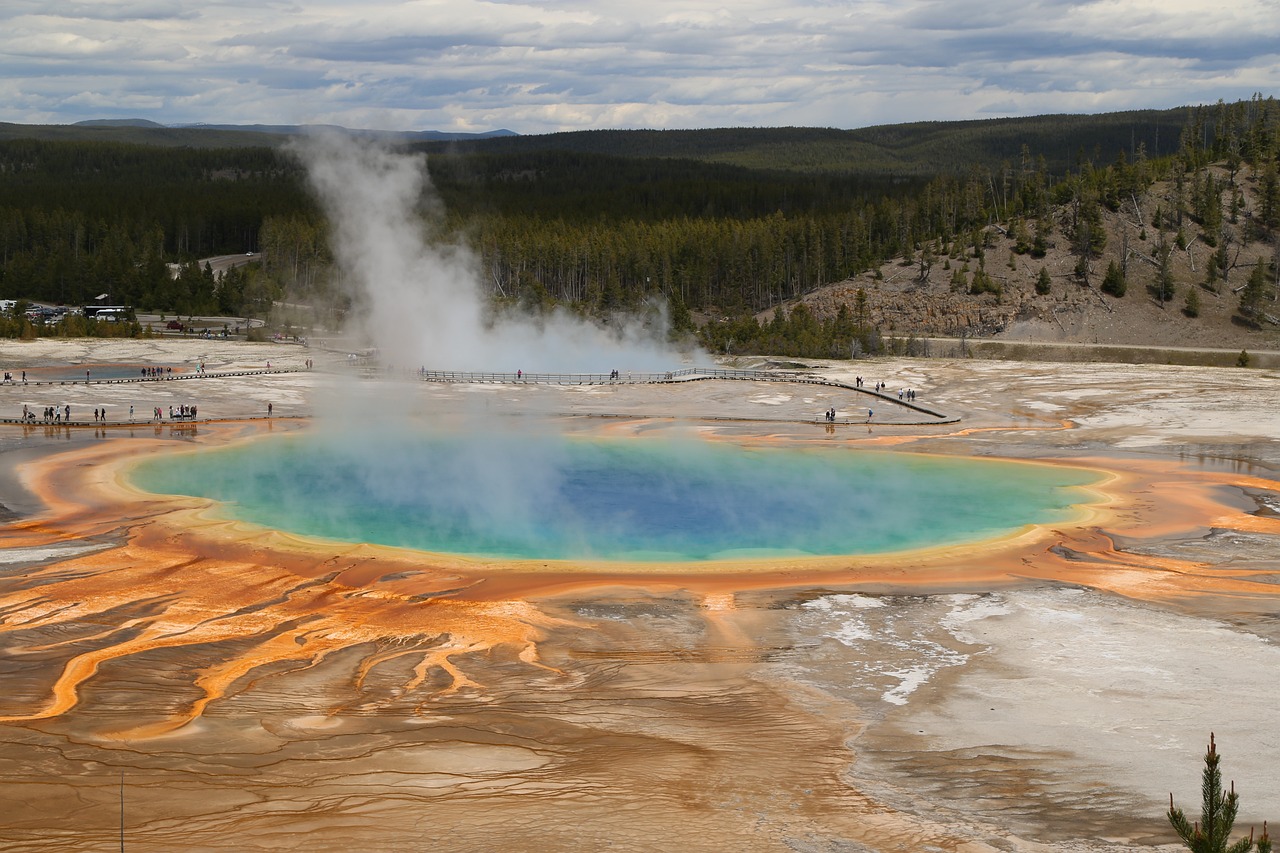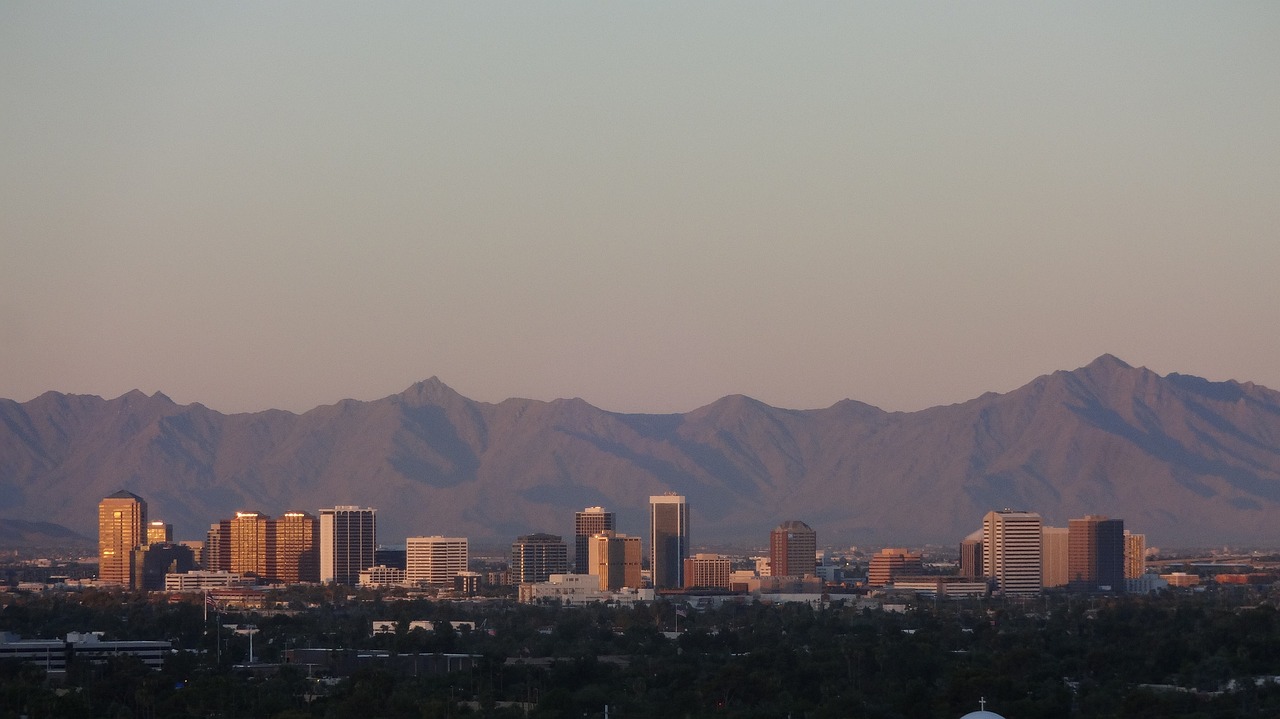
Planning a trip can be tough. Yellowstone National Park is America’s first national park. This guide will show you its wonders, from geysers to wildlife. Keep reading for an adventure!
Key Takeaways
- Yellowstone became America’s first national park in 1872, thanks to a law signed by President Ulysses S. Grant.
- The park is known for its geysers, like Old Faithful, and has over 60% of the world’s geysers.
- Visitors can see many animals such as bison, bears, and wolves. The park also has over 300 bird species.
- There are more than 900 miles of hiking trails for exploring the park’s diverse landscapes.
- Yellowstone offers activities all year, including snowshoeing in winter and fishing in summer.
Key Historical Highlights of Yellowstone National Park

Yellowstone National Park holds the distinction of being America’s first national park, established in 1872. Its early development and preservation efforts are a testament to its historical significance.
The park has played a pivotal role in shaping the concept of preserving natural wonders for future generations.
Establishment as the first national park
On March 1, 1872, President Ulysses S. Grant signed the act that made Yellowstone the first national park in the world. This historic move was aimed at preserving its unique geysers, hot springs, and rugged landscapes for future generations to enjoy.
The idea was groundbreaking. Before this act, no legal protection existed for such wild places anywhere on Earth.
This step marked a new way of thinking about nature and conservation. It sparked a global movement leading to the creation of national parks worldwide. Yellowstone’s establishment set a precedent showing how natural beauty and ecosystems could be protected by law from exploitation and destruction.
Early development and preservation efforts
Right after Yellowstone became the first national park, people started to work hard to protect its beauty. In 1872, it was clear that this special place needed care so animals and landscapes could stay safe for everyone to enjoy.
Early leaders like the U.S. Army played a big role in stopping people from taking advantage of the land. They made rules about hunting and helped stop fires.
The National Park Service took over in 1916, bringing new ideas for keeping the park healthy while letting visitors come see its wonders. They built paths and put up signs, making sure folks could explore without hurting nature.
This balance between visiting and protecting is why we can still enjoy Yellowstone today.
Geological Marvels of Yellowstone
Yellowstone is a geological wonder, with its volcanic activity and the Yellowstone Caldera. The park is home to iconic geysers like Old Faithful and stunning hot springs, showcasing nature’s powerful forces at work.
Volcanic activity and the Yellowstone Caldera
The Yellowstone Caldera is a giant volcano. It’s one of the reasons we have geysers and hot springs in the park. This volcano erupted long ago, around 640,000 years back. Now, it’s not erupting, but it still heats up water underground.
That hot water shoots up and creates geysers like Old Faithful.
This area sits on a volcanic hot spot. Earth’s crust is thin here, which lets heat come up easily from below. So, we see lots of geothermal features all over Yellowstone because of this heat coming from deep inside the Earth.
Iconic geysers, including Old Faithful
Yellowstone National Park is famous for its iconic geysers, with Old Faithful being the most renowned. This natural wonder erupts almost every 90 minutes, shooting hot water and steam up to 184 feet into the air.
It’s a mesmerizing sight, attracting millions of visitors each year. The park boasts over 60% of the world’s geysers, showcasing a unique geological phenomenon that captivates nature enthusiasts and scientists alike.
The hydrothermal features in Yellowstone are a result of underground volcanic activity heating water to extreme temperatures. Old Faithful stands as a testament to this ongoing process, offering an awe-inspiring display of nature’s power and beauty.
Visitors can witness this incredible show while taking in the surrounding scenic landscapes, making it an unforgettable experience within America’s first national park.
Hot springs and hydrothermal features
Yellowstone National Park is famous for its hot springs and hydrothermal features. The park’s geothermal wonders showcase colorful hot springs, boiling mud pots, and erupting geysers.
The Grand Prismatic Spring is one of the largest in the world, spanning approximately 370 feet in diameter with vivid hues caused by heat-loving bacteria thriving in its warm waters.
Additionally, the park contains over 10,000 hydrothermal features, showcasing Yellowstone’s unique geological activity.
Old Faithful Geyser stands out as one of the most iconic attractions, blasting steam and water into the air roughly every 90 minutes. The park’s impressive collection of geysers demonstrates a dynamic landscape shaped by volcanic forces.
Visitors can stroll along boardwalks to observe these natural marvels up close while learning about their formation and significance through informative signage placed throughout these areas.
With more than half of the world’s geysers found within Yellowstone National Park boundaries, it offers an unparalleled opportunity to witness nature’s raw power and beauty firsthand.
Diverse Ecosystem and Wildlife
4. The park is home to a rich variety of animals, from bison and bears to wolves. It also boasts diverse plant life, beautiful wildflowers, and an array of bird species.
Bison, bears, and wolves
Yellowstone National Park is home to an array of fascinating wildlife, including bison, bears, and wolves. Some interesting things you should know about them are:
- Bison:
Bison, also known as buffalo, are an iconic symbol of the American West. They are the largest land mammals in North America and can weigh up to 2,000 pounds. - Bears:
Yellowstone is one of the few areas in the lower 48 states where grizzly bears and black bears can be found together. The park provides crucial habitat for these majestic creatures. - Wolves:
After facing extinction in the region, wolves were successfully reintroduced to Yellowstone National Park in the 1990s. Today, they play a vital role in maintaining a balanced ecosystem.
These magnificent animals contribute to the park’s unique and diverse ecosystem, offering visitors a chance to witness nature at its finest.
Bird species and aquatic life
Yellowstone National Park is home to a diverse array of bird species and aquatic life. The park’s lakes, rivers, and wetlands provide essential habitat for a wide variety of wildlife.
- Over 300 species of birds have been documented in Yellowstone, including bald eagles, ospreys, trumpeter swans, and sandhill cranes.
- The park’s waterways support several species of fish, such as cutthroat trout, Arctic grayling, and mountain whitefish.
- Aquatic life in Yellowstone includes amphibians like frogs and salamanders and a rich diversity of insect species.
The unique combination of avian and aquatic life makes Yellowstone an unparalleled destination for wildlife enthusiasts and nature lovers alike.
Wildflowers and unique plant life
Yellowstone’s diverse ecosystem is also home to a variety of wildflowers and unique plant life. Here are some of the fascinating flora you can discover while exploring the park:
- Paintbrush: These vibrant wildflowers come in various colors and thrive in the park’s meadows and open forests.
- Lodgepole Pine: One of the dominant tree species in Yellowstone, these pine trees play a crucial role in shaping the park’s landscape.
- Bistort: With its distinctive spiraled flower spikes, bistort adds an elegant touch to the wetlands and streamsides within the park.
- Sagebrush: Known for its aromatic scent, sagebrush covers extensive areas of Yellowstone and provides essential habitat for wildlife.
- Beargrass: Found in higher elevations, beargrass showcases tall stalks topped with clusters of white flowers, creating a striking sight during the summer months.
Discovering these wildflowers and plant species adds another layer of beauty and fascination to your Yellowstone experience.
Top Recreational Activities in Yellowstone
Explore picturesque hiking trails, capture stunning wildlife with your camera, and enjoy the tranquility of fishing in Yellowstone’s pristine waters. Discover more about these incredible recreational activities in this blog post.
Hiking trails and backcountry exploration
Discover the awe-inspiring hiking trails and backcountry exploration in Yellowstone National Park. With over 900 miles of hiking trails, there’s something for every level of hiker, from easy strolls to challenging backcountry treks.
Explore iconic paths like the Uncle Tom’s Trail offering breathtaking views of the Lower Falls or the Mount Washburn Trail leading to panoramic vistas.
Immerse yourself in the park’s diverse landscapes, from lush forests and meadows to rugged mountains and geothermal areas. Don’t miss out on remote backcountry adventures where you can witness untouched natural beauty and experience true wilderness.
Whether you’re a seasoned hiker or a nature enthusiast, Yellowstone’s trails offer an unforgettable journey through some of America’s most pristine wilderness.
Wildlife viewing and photography
Yellowstone National Park is home to diverse wildlife, including bison, bears, wolves, and over 300 bird species. The park’s abundant wildlife provides excellent opportunities for photography and observation.
Bison freely roam the plains while grizzly bears and wolves can be spotted in their natural habitat. In addition to terrestrial animals, the park also boasts a variety of aquatic life in its rivers and lakes.
With such a rich ecosystem, visitors are presented with prime chances for capturing stunning nature photography.
Exploring Yellowstone’s wilderness offers an up-close encounter with these magnificent creatures amidst breathtaking landscapes. The park’s unique geothermal features add an extra layer of wonder to your wildlife viewing experience.
As you venture through Yellowstone’s terrain, keep your camera ready for captivating shots of both the iconic Old Faithful geyser and the fascinating animal kingdom that calls this national treasure home.
Next up – Fishing and boating opportunities
Fishing and boating opportunities
After enjoying the wildlife viewing and photography, visitors can also explore fishing and boating opportunities in Yellowstone National Park. The park offers various lakes, rivers, and streams where anglers can try their luck at catching cutthroat trout, rainbow trout, brown trout, or brook trout.
Yellowstone Lake is a popular spot for boating and provides access to beautiful backcountry areas which cannot be reached by roads.
The park’s fishing season typically begins in late May after the ice on the lakes melts. Anglers must have a valid Yellowstone National Park fishing permit which can be purchased at any of the park’s visitor centers.
Boaters are required to follow certain regulations to protect against aquatic invasive species. All these activities offer an exceptional way for visitors to experience the natural beauty of the park while engaging in outdoor adventure.
Seasonal Adventures in Yellowstone
Embrace winter snowshoeing and snowmobiling through the park’s pristine landscapes. Encounter spring awakening and summer thrills amidst Yellowstone’s natural wonders.
Winter snowshoeing and snowmobiling
Winter in Yellowstone is a wonderland for snow enthusiasts. Snowshoeing allows you to explore the park’s serene beauty at your own pace, offering an up-close experience with its diverse wildlife and unique geothermal features.
The park offers more than 250 miles of trails for snowmobiling, giving adrenaline junkies an opportunity to traverse the snowy landscapes while taking in spectacular views of the park’s iconic sights like Old Faithful and the Grand Canyon of the Yellowstone.
Yellowstone’s winter season lasts from mid-December through March when visitors can expect an average snowfall of over 150 inches, creating perfect conditions for these activities.
As you venture out on your winter adventure, keep an eye out for bison, elk and other wildlife that are often easier to spot against the pristine white backdrop. Whether you’re seeking peaceful solitude or thrilling speed, Yellowstone’s winter wonderland has something magical to offer every visitor.
Spring and summer activities
Spring and summer are perfect for exploring Yellowstone’s scenic hiking trails, providing exceptional opportunities to observe the blooming wildflowers and catch glimpses of diverse wildlife.
Visitors can enjoy fishing in pristine mountain lakes, with plentiful trout species creating an angler’s paradise. Boating on Yellowstone Lake is also a popular choice during this time, offering breathtaking views of the surrounding landscape.
Additionally, wildlife viewing and photography reach their peak as animals emerge from hibernation and graze among the lush green meadows.
Visitors should take advantage of abundant daylight hours by partaking in backcountry exploration activities such as camping or birdwatching. The pleasant weather creates ideal conditions for outdoor adventures like geysers sightseeing, where iconic features like Old Faithful demonstrate their power amidst the natural beauty of the park.
Outdoor enthusiasts can embrace conservation efforts through hands-on experiences that foster appreciation for nature’s wonders.
Tips for Visiting Yellowstone National Park
Plan your visit during the quieter seasons to avoid crowds and make the most of your experience. Explore the diverse lodging options available within and around the park for a comfortable stay amidst nature’s beauty.
Best times to visit and avoid crowds
The best times to visit Yellowstone National Park are in the shoulder seasons of late spring and early fall. During these times, the weather is generally mild, and there are fewer visitors compared to the peak summer months.
If you want to avoid crowds, consider visiting during weekdays rather than weekends when the park tends to be busier.
Another good option is to explore the park early in the morning or later in the afternoon when many day-trippers have already left. Keep in mind that July and August are typically the busiest months due to summer vacationers, so if you prefer a quieter experience, it’s best to plan your trip outside of these months.
By choosing less crowded times for your visit, you can fully appreciate the beauty and serenity of this national treasure without feeling rushed or overcrowded. Plan your trip strategically for a more enjoyable experience exploring Yellowstone National Park.
After considering crowd avoidance tips for Yellowstone National Park let’s dive into lodging and campground options as part of planning your visit.
Lodging and campground options
After exploring the best times to visit and avoid crowds in Yellowstone National Park, it’s essential to consider lodging and campground options. The park offers various accommodation choices ranging from rustic cabins, motels, and lodges to campgrounds suitable for tents and RVs.
There are over 2,000 campsites available at 12 campgrounds scattered throughout the park. Additionally, there are nine lodges operated by a concessioner that offer different levels of amenities from basic rooms to more luxurious accommodations.
Advance reservations are highly recommended due to the high demand for lodging during peak seasons.
Yellowstone National Park also provides five reservation campgrounds for visitors who prefer a more traditional camping experience with facilities like restrooms, showers, and laundry services available.
It’s important to note that these campgrounds usually get booked months in advance during the busy summer season. For those who want a less crowded experience or plan on visiting during shoulder seasons or winter, several campgrounds without reservations operate on a first-come-first-served basis offering fewer amenities but with stunning natural surroundings.
Park rules and safety guidelines
Before delving into the wonders of Yellowstone National Park, it’s crucial to be aware of the park rules and safety guidelines. Yellowstone is wild and unpredictable, so staying on designated paths and boardwalks is vital for your safety as well as protecting the park’s delicate geothermal features.
It’s essential to keep a safe distance from wildlife; maintain at least 100 yards from bears and wolves, and 25 yards from all other animals. Remember that drones are not permitted in the park due to potential harm to wildlife.
Be aware that swimming in hot springs or other hydrothermal features is strictly forbidden owing to their extreme temperatures, which can cause severe burns or even death. Also, camp only in designated areas to safeguard both you and the environment.
Always check for current regulations regarding fishing permits before casting your line at any of Yellowstone’s waterways—compliance with these rules aids conservation efforts while preserving outdoor recreation opportunities for everyone.
Conclusion
As you prepare to explore Yellowstone National Park, be ready for a journey through America’s first national park. Experience its rich history and the remarkable volcanic features that make the park unique.
Discover diverse wildlife and immerse yourself in outdoor adventures like hiking, wildlife viewing, and fishing. Remember to plan your visit carefully for an unforgettable experience at Yellowstone.
FAQs
1. What makes Yellowstone National Park special?
Yellowstone is America’s first national park, known for its stunning landscapes, diverse wildlife, and unique geothermal features like geysers and hot springs. It offers countless adventures in nature.
2. When is the best time to visit Yellowstone?
The best time to visit Yellowstone is during spring or fall. The weather is mild, and the crowds are smaller compared to summer. You can enjoy beautiful views of wildflowers or colorful foliage.
3. How can I explore the park’s wonders?
You can explore Yellowstone by hiking its many trails, driving through scenic routes, or taking guided tours that show you all the highlights. Wildlife watching is also popular; keep your camera ready!
4. Are there any safety tips for visiting Yellowstone?
Yes! Always stay on marked paths near geothermal areas, keep a safe distance from animals, especially bears and bison, and be prepared for sudden weather changes while exploring this amazing national park.







Leave a Reply